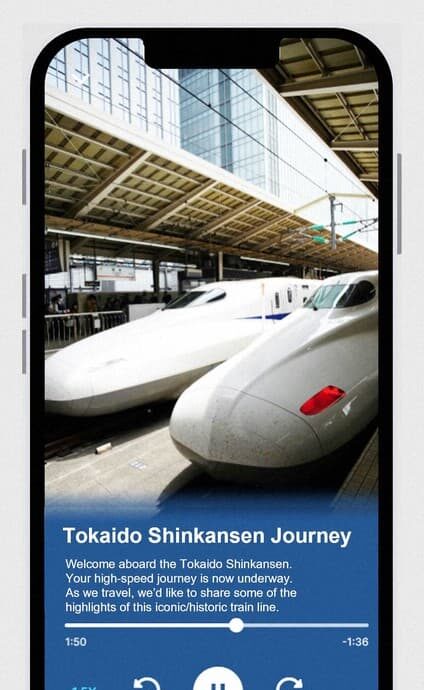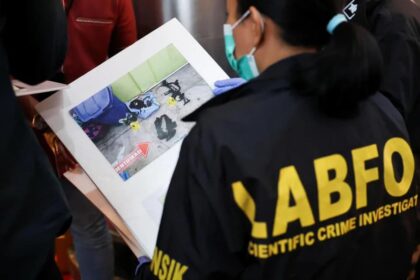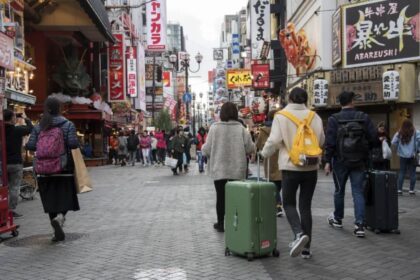What is changing for visitors on the Tokaido Shinkansen
Central Japan Railway Company (JR Central) will pilot a multilingual AI travel assistant at JR Shinagawa Station in Tokyo. From December 15 to mid March, foreign visitors riding the Tokaido Shinkansen can scan station QR codes with a smartphone to open a dedicated mobile site. An AI chatbot will answer practical questions about train operations, ticket purchases, seat types, boarding procedures, and how to handle large luggage. The service supports English, Chinese, Korean, French, and Spanish.
- What is changing for visitors on the Tokaido Shinkansen
- How the JRTok AI assistant will work
- Which languages are covered and why it matters
- Why language assistance matters for Japan travel now
- Benefits and limits of generative AI in transport
- Measuring success during the winter trial
- How this fits with wider railway digital services
- Tips for travelers using the trial at Shinagawa
- What to Know
JR Central is branding the trial JRTok AI. The assistant uses location based prompts to surface nearby guidance in the station and on board. During the journey it includes English commentary about the history and culture along the line. The company says results from the trial will guide future improvements and potential expansion to other stations and routes.
Shinagawa is a key entry point to the Tokaido Shinkansen, the high speed route linking Tokyo, Nagoya, and Osaka. The corridor carries large crowds every day, with especially heavy traffic over the year end holiday period. Visitors often face the same questions, from where to buy the right ticket to where to place large suitcases. An on demand guide that works on any modern phone aims to reduce confusion and speed up decisions for newcomers to Japan rail travel.
How the JRTok AI assistant will work
The experience is designed to be simple. No download is required. Travelers scan a QR code placed on signs or at information counters, choose a language, then type a question or tap common topics. The chatbot draws on official guidance to explain ticket options, seat reservations, baggage rules, and directions within the station. If there are schedule changes, it can point users to the correct platform and provide updates pulled from public notices.
Getting started at Shinagawa
After scanning the code, the mobile site opens in the phone browser. A home screen presents common needs such as buy a ticket, find my platform, and luggage. Users can search in their own language. Answers aim to be short and clear, with links to maps or official pages when needed. The assistant is meant to support, not replace, station staff. Travelers can still walk up to counters for help.
Tickets and seats
The assistant can explain the difference between reserved seats, non reserved cars, and Green Class, and how to choose a service with fewer transfers. It can describe how to buy at ticket machines, counters, or online, and how to use QR codes or IC cards where available. For international travelers, it can outline the SmartEX and smart phone ticket routes, and remind users to bring the same credit card used at purchase when collecting physical tickets. Payments themselves continue to run through official channels, not through the chatbot.
Luggage and on board etiquette
JR Central has specific rules for large suitcases on the Tokaido Shinkansen. The assistant can explain size categories, when a seat with an oversized baggage area is needed, and where to store medium bags. It can also cover common etiquette, such as keeping aisles clear, setting phones to silent, and using the spaces between seat rows for mid size bags. Clear guidance on these basics helps reduce friction in busy cars.
For riders who want context during the journey, the tool includes optional English commentary about the scenery and landmarks along the route. This is aimed at making the ride more informative for first time visitors while keeping the core travel guidance front and center.
Which languages are covered and why it matters
The trial supports English, Chinese, Korean, French, and Spanish. Together these cover a large share of visitors using the Tokyo to Osaka corridor. English is a common bridge language among many travelers. Chinese and Korean match regional visitors who often ride the Shinkansen between major cities. French and Spanish cover many European and Latin American visitors who may be on longer trips.
The cultural commentary during the ride is provided in English at launch. The company can add more languages over time if the trial shows strong demand. Providing five languages from day one is a practical compromise, since adding many options can slow responses and make quality control harder.
Why language assistance matters for Japan travel now
International travel to Japan has rebounded. Many visitors arrive with limited Japanese and face a complex set of choices the first time they use high speed rail. Station signage and pictograms cover the basics, yet questions about ticket types, seat layouts, and luggage spaces still come up at counters and gates. A multilingual assistant that runs on a phone can bridge this gap at any hour, which helps when crowds are thick and staff time is tight.
Research on language access in other fields shows gains when technology helps connect people to the right information while keeping humans in the loop. Hospitals have used AI to flag patients who need interpreter support so scarce staff can be scheduled more efficiently. Education researchers are testing chatbots to coach providers through sensitive conversations in a controlled way, while watching for errors and privacy risks. Public transportation is a simpler use case than clinical care, yet the lesson applies. Tools that surface clear instructions quickly can reduce stress for travelers and free up staff for complex cases.
Benefits and limits of generative AI in transport
Modern chatbots are built on large language models, systems trained to predict the next word based on huge amounts of text. They can explain steps in plain language and handle many different phrasings. They can also make mistakes if a question falls outside their knowledge. The best practice is to ground answers in official documents and restrict responses to verified guidance. That reduces the risk of false or outdated advice.
Experts studying generative AI point to a trade off. These tools can increase productivity in service settings like hospitality and tourism, but they carry real concerns about bias, accuracy, and data privacy. A transport assistant should minimize data collection, avoid storing personal identifiers, and give clear notices about how conversations are used to improve the system. Human supervisors should review edge cases and refine the content library so the assistant gets better at the questions visitors actually ask.
Measuring success during the winter trial
JR Central plans to review the trial results before deciding on next steps. Key signals will include how many travelers scan the code, how often they return, and how quickly people find answers. The mix of languages used will show where demand is strongest. Accuracy can be tracked through feedback buttons and by sampling conversation logs for corrections. The team can also watch for repeated questions that point to unclear signage or confusing machine flows.
The timing covers long weekends and the year end holiday period, when lines are crowded and questions spike. That gives the company a chance to test the assistant under load, and to see if it helps reduce queues at counters. If it works, it could become a standard part of the station toolkit alongside signs, maps, and announcements.
How this fits with wider railway digital services
Japan rail companies have moved a growing share of information onto phones, from seat reservations to real time alerts. JR Central already supports online ticketing through SmartEX and offers free Wi Fi on many Shinkansen trains. Multilingual digital signage and station maps are common in big hubs. A chat based guide adds a conversational layer over these tools, which can be faster for a first time user than drilling through menus.
Future versions could tie into real time delay notices, transfer guidance across different JR groups, or city transit connections. It may also support more languages as visitor patterns change. Any expansion will depend on how well the trial handles accuracy, privacy, and peak load at busy times.
Tips for travelers using the trial at Shinagawa
Look for QR code signs near Shinkansen entrances, information counters, and ticket areas at JR Shinagawa Station. Scan with your phone camera and tap the link that appears. Select your language and start with common topics like buy a ticket or where is my platform. Station Wi Fi is available in many areas, and Shinkansen cars offer free Wi Fi on most services, which helps if you do not have a data plan.
Do not enter passport numbers, credit card details, or home addresses into chat. The assistant is designed to give guidance, not to process sensitive information. For urgent issues like a lost child, medical needs, or items on the tracks, speak to a station attendant right away.
What to Know
- JR Central will run an AI language assistant trial at JR Shinagawa Station from December 15 to mid March.
- Travelers can scan QR codes to open a mobile site, with support for English, Chinese, Korean, French, and Spanish.
- The assistant answers questions about tickets, seating, platforms, and luggage rules for the Tokaido Shinkansen.
- Location based prompts and optional English commentary provide guidance during the ride.
- No app download is required and payments still happen through official channels.
- JR Central will study usage, accuracy, and feedback before deciding on expansion.
- The trial coincides with a busy travel season, including year end holidays.
- Generative AI can speed up service, yet it needs guardrails for accuracy and privacy.
- Travelers should avoid sharing sensitive data in chat and seek staff for urgent issues.
- If successful, similar tools could appear at more stations and in more languages.












